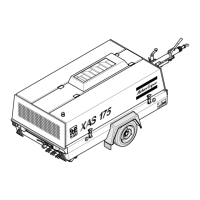- 23 -
CONTINUOUS PNEUMATIC REGULATING
SYSTEM
The compressor is provided with a continuous
pneumatic regulating system. This system is provided
with a blow-down valve, which is integrated in the
unloader assembly. The valve is closed during
operation by outlet pressure of the compressor
element and opens by air receiver pressure when the
compressor is stopped.
When the air consumption increases, the air receiver
pressure will decrease and vice versa. This receiver
pressure variation is sensed by the regulating valve
which, by means of control air to the unloader,
matches the air output to the air consumption. The air
receiver pressure is maintained between the
preselected working pressure and the corresponding
unloading pressure.
When starting the compressor, the unloader valve in
the unloader assembly (UA) is kept open by spring
force, the engine runs at maximum speed. The
compressor element (CE) takes in air and pressure
builds up inside the receiver (AR).
The air output is controlled from maximum output
(100%) to no output (0%) by:
1. Speed control of the engine between maximum
load speed and unloading speed (the output of a
screw compressor is proportional to the rotating
speed).
2. Air inlet throttling.
If the air consumption is equal to or exceeds the
maximum air output, the engine speed is held at
maximum load speed and the unloading valve is fully
open.
If the air consumption is less than the maximum air
output, the regulating valve supplies control air to
unloader assembly (UA) to reduce the air output and
holds air receiver pressure between the normal
working pressure and the corresponding unloading
pressure at approx. 1.5 bar (22 psi) above the normal
working pressure.
When the air consumption is resumed, the unloader
valve in the unloader assembly (UA) gradually opens
the air intake and the speed regulator (SR) increases
the engine speed.
The construction of the regulating valve (RV) is such
that any increase (decrease) of the air receiver
pressure above the pre-set valve opening pressure
results in a proportional increase (decrease) of the
control pressure to the unloading valve and the speed
regulator.
Part of the control air is vented into the atmosphere,
and any condensate discharged, through the vent
holes.

